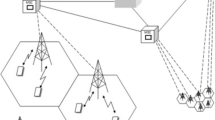Abstract
The majority of call admission control schemes proposed for wireless cellular networks do not take new call redials into account. However, connection reattempts are known to have a negative impact on the system performance because they generate more load. In this paper, we shall investigate how some popular call admission control schemes perform under more realistic conditions.




























Similar content being viewed by others
References
Abdulova, V., & Aybay, I. (2011). Predictive mobile-oriented channel reservation schemes in wireless cellular networks. Wireless Networks, 17(1), 149–166.
Abdulova, V., & Aybay, I. (2014). Performance evaluation of non-prioritized and prioritized call admission control schemes in wireless cellular networks. Wireless Personal Communications, 78(1), 69–84.
Tekinay, S., & Jabbari, B. (1991). Handover and channel assignment in mobile cellular networks. Communications Magazine, IEEE, 29(11), 42–46.
Li, B., Li, L., Li, B., & Cao, X. R. (2003). On handoff performance for an integrated voice/data cellular system. Wireless Networks, 9(4), 393–402.
Hong, D., & Rappaport, S. S. (1986). Traffic model and performance analysis for cellular mobile radio telephone systems with prioritized and nonprioritized handoff procedures. Vehicular Technology, IEEE Transactions on, 35(3), 77–92.
Pati, H. K. (2013). A control-period-based distributed adaptive guard channel reservation scheme for cellular networks. Wireless Networks, 19(7), 1739–1753.
Fazio, P., & Marano, S. (2012, July). A new Markov-based mobility prediction scheme for wireless networks with mobile hosts. In 2012 international symposium on performance evaluation of computer and telecommunication systems (SPECTS) (pp. 1–5). IEEE.
Hong, D., & Rappaport, S. S. (1989). Priority oriented channel access for cellular systems serving vehicular and portable radio telephones. IEE Proceedings I (Communications, Speech and Vision), 136(5), 339–346.
Somagari, S. R., & Pati, H. K. (2012). An analytical model for adaptive multi-guard channel scheme for multi-class traffic in cellular networks with reduced handoff drop probabilities. Procedia Technology, 6, 690–697.
Martinez-Bauset, J., Gimenez-Guzman, J. M., & Pla, V. (2012). Robustness of optimal channel reservation using handover prediction in multiservice wireless networks. Wireless Networks, 18(6), 621–633.
Katzela, I., & Naghshineh, M. (1996). Channel assignment schemes for cellular mobile telecommunication systems: A comprehensive survey. IEEE Personal Communications, 3(3), 10–31.
Purzynski, C., & Rappaport, S. S. (1995). Multiple call handoff problem with queued handoffs and mixed platform types. IEE Proceedings on Communications, 142, 31–39.
Li, B., Lin, C., & Chanson, S. T. (1998). Analysis of a hybrid cutoff priority scheme for multiple classes of traffic in multimedia wireless networks. Wireless Networks, 4, 279–290.
Tran-Gia, P., & Mandje, M. (1997). Modeling of customer retrial phenomenon. IEEE Journal on Selected Areas in Communications, 15(8), 1406–1414.
Shingawa, N., Kobayashi, T., Nakano, K., & Sengoku, M. (2000). Teletraffic characteristics in prioritized hand-off control method considering reattempted calls. IEICE Transactions on Communications, E83-B(8), 1810–1818.
Marco Ajmone Marsan. (2000). An approximate model for the computation of blocking probabilities in cellular networks with repeated calls. Springer Telecommunication Systems, 15(1–2), 53–62.
Gimenez-Guzman, J. M., Domenech-Benlloch, J., Pla, V., Casares-Giner, V., & Martinez-Bauset, J. (2007). Analysis of a cellular network with user redials and automatic handover retrials. Lecture Notes in Computer Science, 4712, 210–222.
Abdulova, V., & Aybay, I. (2011). A prioritized new call queuing policy for multimedia wireless cellular networks. Journal of Internet Technology, 12(3), 491–502.
Wang, J., Zeng, Q.-A., & Agrawal, D. P. (2003). Performance analysis of a preemptive and priority reservation handoff scheme for integrated service-based wireless mobile networks. IEEE Transactions on Mobile Computing, 2, 65–75.
GPSS World Simulation Package. http://www.minutemansoftware.com/simulation.htm (last visited: 23.04.2015).
Author information
Authors and Affiliations
Corresponding author
Rights and permissions
About this article
Cite this article
Abdulova, V., Aybay, I. Performance Evaluation of Call Admission Control Schemes with New Call Reattempts in Wireless Cellular Networks. Wireless Pers Commun 84, 2859–2879 (2015). https://doi.org/10.1007/s11277-015-2770-y
Published:
Issue Date:
DOI: https://doi.org/10.1007/s11277-015-2770-y




